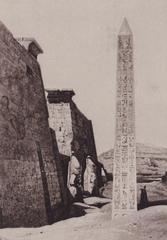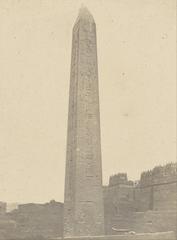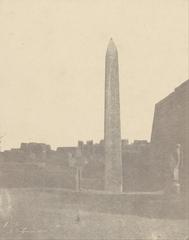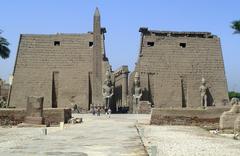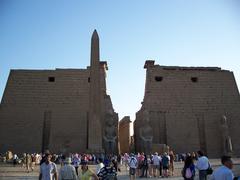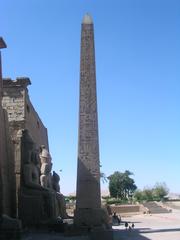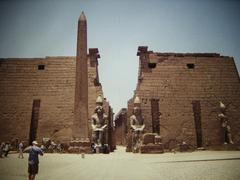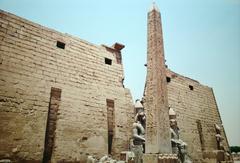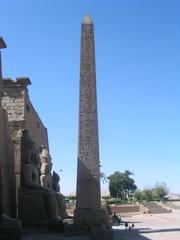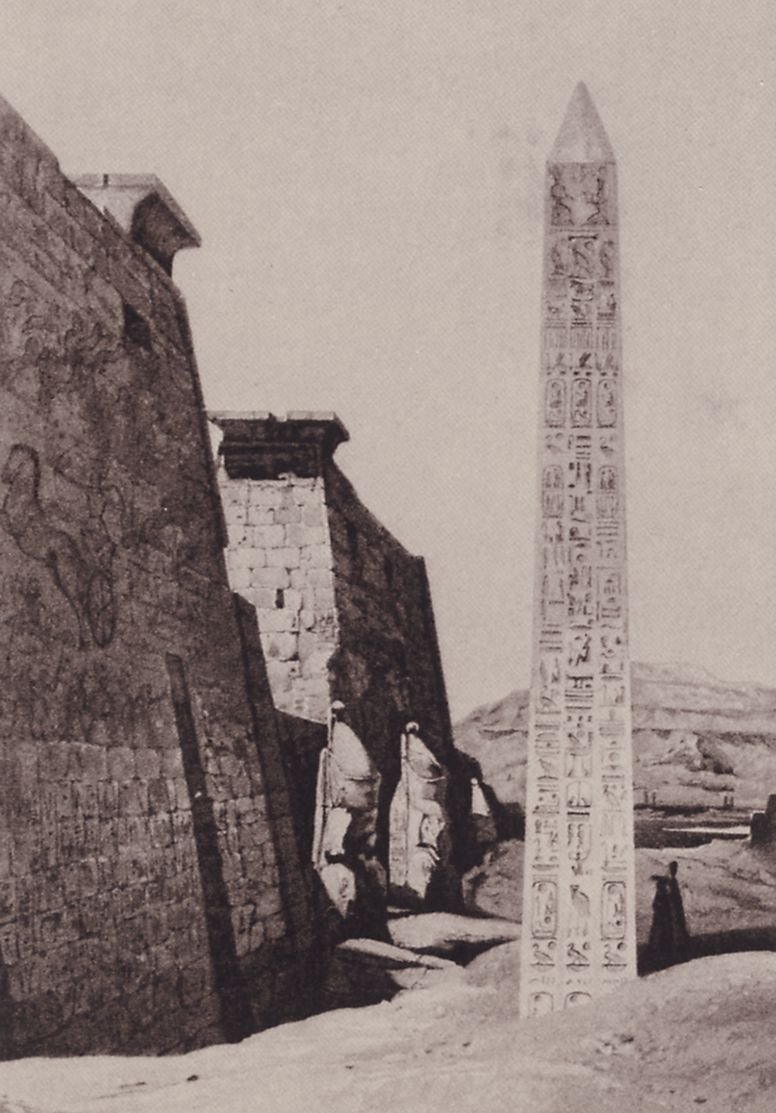
Luxor Obelisk: Visiting Hours, Tickets, and Historical Significance in Luxor, Egypt
Date: 14/06/2025
Introduction
The Luxor Obelisk, a monumental red granite pillar standing at the entrance of the ancient Luxor Temple in Egypt, is a striking testament to the grandeur, ingenuity, and spiritual devotion of ancient Egyptian civilization. Erected during the reign of Pharaoh Ramesses II, this obelisk not only exemplifies the engineering mastery of its creators but also serves as a profound symbol of the pharaoh’s divine authority and the enduring legacy of Egypt’s religious traditions. In this guide, you’ll find essential information on visiting hours, ticketing, accessibility, and travel tips, along with insights into the obelisk’s fascinating history and ongoing preservation efforts. Whether you’re planning a trip or seeking a deeper understanding of this iconic landmark, this article is your comprehensive resource for exploring the Luxor Obelisk (Luxwisp; Archaeology Travel; Living Nomads).
Historical Background and Symbolism
Origins and Meaning
The Luxor Obelisk was originally one of a pair commissioned by Ramesses II (c. 1279–1213 BCE), meant to flank the entrance of the Luxor Temple, a major religious center dedicated to the Theban Triad: Amun, Mut, and Khonsu (Luxwisp; History Egypt). Obelisks in ancient Egypt were far more than architectural ornaments; their pointed form and pyramidion (top) embodied a petrified ray of sunlight, closely tied to the sun god Ra. They functioned as conduits between the divine and the earthly, declaring the pharaoh’s legitimacy and the cosmic order he maintained (Archaeology Travel).
Construction and Artistic Mastery
Carved from a single block of granite quarried in Aswan, the Luxor Obelisk stands about 23–25 meters (75–82 feet) tall and weighs roughly 220–227 tons (Archaeology Travel; Luxwisp; worldinparis.com). The monument’s surfaces are adorned with intricate hieroglyphic inscriptions glorifying Ramesses II’s achievements and divine right, functioning as both historical records and spiritual invocations (worldhistoryedu.com). Notably, recent research has uncovered “crypto-hieroglyphs”—hidden messages visible only from certain angles or to specific viewers, hinting at the sophisticated use of monuments for public and secret propaganda (dailygalaxy.com).
Ritual and Religious Significance
Placed at the temple entrance, the obelisks were focal points during religious festivals such as the Opet Festival, when the statue of Amun was carried from Karnak to Luxor. Their bases, often adorned with baboon sculptures, reinforced solar symbolism—baboons were believed to worship the sun at dawn (Archaeology Travel). The obelisk’s alignment and inscriptions thus linked the pharaoh’s earthly power with the cosmic order and the favor of the gods.
Visitor Information
Location and Setting
The Luxor Obelisk stands at the entrance of Luxor Temple, located on the east bank of the Nile in Luxor City. The site is easily accessible from the city center and is surrounded by other important archaeological attractions (Living Nomads; weseektravel.com).
Getting There
- On Foot: Central Luxor is walkable; the temple is conveniently located for pedestrians.
- By Taxi or Carriage: Taxis and traditional horse-drawn carriages are widely available.
- Guided Tours: Many choose organized tours, which often include transportation and expert commentary.
Visiting Hours and Tickets
- Opening Hours: Daily, 6:00 AM – 10:00 PM (Living Nomads).
- Ticket Prices: 160 EGP per adult (as of 2024). Discounts may be available for students and children; check official sources for updates.
- Night Visits: The temple and obelisk are illuminated after sunset, offering a magical experience for evening visitors.
Accessibility and Facilities
- Flat walkways make the area around the obelisk accessible, though some uneven surfaces and steps exist within the temple.
- Restrooms and vendors are located near the entrance.
- Wheelchair access is possible, but some areas may require assistance.
Guided Tours and Interpretation
- Licensed Egyptologist guides are available at the entrance and through tour operators, offering in-depth historical and cultural insights (Intrepid Scout).
- Audio guides and group tours are also available for an enhanced experience.
Highlights and Travel Tips
When to Visit
- Best Season: October to April for cooler, more comfortable weather (Holidify).
- Best Time of Day: Early morning or late afternoon for optimal lighting and smaller crowds.
What to Bring
- Sun protection (hat, sunglasses, sunscreen)
- Water
- Comfortable walking shoes
- Camera or smartphone
- Local currency for tickets and vendors
Etiquette and Safety
- Do not touch or climb the obelisk or other monuments.
- Photography is allowed; drones require special permission.
- Secure your belongings and respect all posted guidelines.
Nearby Attractions
- Karnak Temple: Connected to Luxor Temple by the historic Avenue of Sphinxes.
- Luxor Museum: Showcases artifacts and smaller obelisks.
- Valley of the Kings and Queens: A short drive away.
- Avenue of Sphinxes: Recently restored, it once linked Luxor and Karnak temples.
- Hot Air Balloon Rides & Felucca Cruises: Popular for panoramic views and Nile experiences.
Preservation and Recent Discoveries
Modern conservation efforts focus on stabilizing the Luxor Obelisk, cleaning its surfaces, and protecting its inscriptions from environmental threats (chatillonarchitectes.com). Advanced technologies like 3D scanning and non-invasive techniques are now used, drawing on expertise gained from preserving the obelisk’s twin in Paris. Ongoing research continues to reveal new insights into the obelisk’s hidden hieroglyphs and ritual significance (thearchaeologist.org).
The Fate of the Twin Obelisks
Originally, two obelisks stood at Luxor Temple’s entrance. In the 19th century, both were offered to France, but only one was transported and now stands at Paris’s Place de la Concorde. The logistical feat of moving the 227-ton monument was immense and is commemorated on its Parisian pedestal. In the late 20th century, France officially renounced claims to the remaining obelisk, ensuring it would remain in Egypt (Archaeology Travel).
Frequently Asked Questions (FAQ)
What are the Luxor Obelisk’s visiting hours?
Daily from 6:00 AM to 10:00 PM.
How much are tickets?
160 EGP per adult (verify current rates before visiting).
Are guided tours available?
Yes, at the entrance and through many operators.
Is the site accessible?
Generally flat and accessible, though some temple areas have uneven terrain.
Can I visit at night?
Yes, both the obelisk and temple are illuminated after sunset.
Are there restrictions on photography?
Personal photography is allowed, but drones need special permission.
Conclusion
The Luxor Obelisk is a striking symbol of ancient Egyptian power, artistry, and religious tradition. With its towering presence, intricate inscriptions, and ongoing preservation, it offers visitors a unique connection to the civilization that shaped human history. Plan your visit during the recommended hours, secure your tickets in advance, and make the most of your experience by exploring the broader Luxor temple complex and nearby attractions. For additional travel tips, updates, and interactive resources, consider downloading the Audiala app and following official Luxor tourism channels.
Further Reading and Official Sources
- Luxwisp – Facts About the Temple of Luxor
- Archaeology Travel – The Luxor Obelisk and Its History
- Living Nomads – Visiting Luxor: Travel Guide
- WorldHistoryEdu – Luxor Obelisks: History and Significance
- Daily Galaxy – Hidden Messages on the Luxor Obelisk
- Nile Cruisez – Temple of Luxor Guide
- Chatillon Architectes – Obelisque de Louxor
- Weseektravel – Things to Do in Luxor
For official ticketing and visitor updates:
For more on Luxor’s historical sites and travel inspiration, explore our related articles and plan your unforgettable journey.
